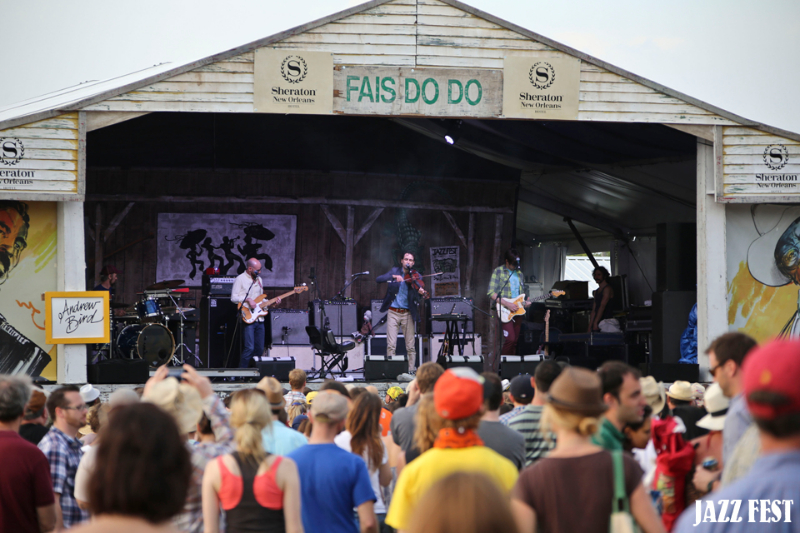
The year 2013 was definitely an odd year for the New Orleans Jazz & Heritage Festival, and not just in the numeric sense. The event’s organizers, a week after the festival’s final notes had sounded, publicly summed up the experience as “the best worst fest in history.” While they were specifically referring to this spring’s unseasonably cool and rainy weather — “the coldest Jazz Fest ever,” according to one local TV weather forecaster — for long-time festival observers like myself (having now racked up close to 25 years of attendance), Jazz Fest 2013 was noteworthy for a whole host of other reasons. It was a year that marked both a sea-change in the public face of New Orleans music and one in which the inauguration of live-streaming TV and audio put the final pieces in place for full corporatization of the event that has been many years in the making. And while organizers may want remember it as “the best worst fest in history,” Jazz Fest 2013 will more likely be remembered in New Orleans music history as the year a new generation of New Orleans musicians moved into the front ranks, while the overall structure of the event — buoyed now by near-total digital access — solidified the nature of the event and the shape of things to come for the foreseeable Jazz Fest future.
Videos by American Songwriter
The Jazz Fest Experience: Still Classic After All These Years
How cold was Jazz Fest 2013, exactly? Those of you who endured winter-like temperatures in regions across the U.S. and even in locations overseas when you were expecting instead a warm and sunny spring may find it amusing, but Jazz Fest’s chilliest day, Sunday, May 5, the final day of the festival, was preceded by lows mostly in the 50s and highs that struggled to break into the 70s. In the past, Jazz Fest often marked a transition from spring to the initial appearance of New Orleans’ summer weather: highs flirting with the upper 80s combined with sweat-inducing humidity. This year, for the first time in roughly 25 years, I found myself entering the Fair Grounds horse-racing track, where the fest is staged, surrounded by large numbers of fans wearing long pants and light jackets or windbreakers. Being a hardy New England transplant, I wasn’t all that uncomfortable in shorts and a short-sleeved linen shirt, but I did notice my skin occasionally sending my brain clear signals the weather was unquestionably chilly.
Once inside the festival gates, however, what I found was the same amazing cornucopia of musical, edible, and informal-marketplace experiences that continue to make the New Orleans Jazz Fest a musical event like no other. For example? A brief summary of Sunday’s highlights: The New Orleans Spiritualettes, a gospel contingent fronted by a half-dozen women of considerable size and dignified seniority came ready to rock the Gospel Tent with a sturdy back-up band and a pre-planned repertoire composed almost entirely of familiar, secularly popular spirituals like “This Little Light of Mine,” “If I Had a Hammer,” “Down by the Riverside,” “When the Saints Go Marching In,” and “Amen.” As often happens in the Gospel Tent, they feel into such a heavenly groove that both the musicians and the audiences wouldn’t have minded if they played well beyond their allotted time slot. But a schedule is a schedule, after all, and having a dozen stages all running in accordance is one of the factors that makes Jazz Fest the pleasurable event it usually is: you can roam the grounds, schedule in hand, and count on performers being on stage when the schedule dictates.
I filled the rest of my final Sunday enjoying multiple sets at the smaller, outdoor Fais Do-Do stage, the mainly Cajun and zydeco venue with a decidedly rural bent that also tends to host the kind of acts American Songwriter readers would probably be familiar with, this year including roots aficionado Andrew Bird, slide-guitar ace Jerry Douglas, The Little Willies, and the Del McCoury Band. After that, it was off to the festival’s largest stage, underwritten by Acura, to check out The Meter Men, a variation on the New Orleans classic funk band The Meters with Page McConnell, formerly with Phish, substituting on keyboards for the venerable Art Neville — they were playing The Meter’s music all right, but not up to The Meters’ reliably sublime standard. Then, since the festival’s (modern) Jazz Tent is located in a far corner of the Jazz Fest layout almost directly behind the Acura Stage, I went hear The Wayne Shorter Quartet, one of this year’s modern-jazz headliners. Grouped closely together around the inward curve of the grand piano, the band played pretty much what you might expect — avant-garde-flavored, very modern, and slightly disjointed nightclub jazz. The musicians involved, including Danilo Perez on piano, John Patitucci on bass, and Louisiana native Brian Blade on drums, all possess such virtuoso skills and a kind of innate-genius talent that even the expected, at that moment, sounded fresh and compelling.













Leave a Reply
Only members can comment. Become a member. Already a member? Log in.